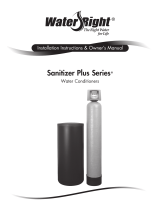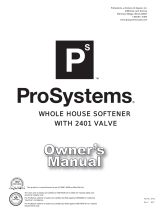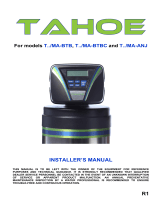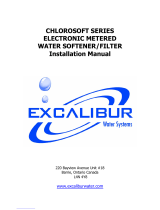
18
Sodium or Calcium Hypochlorite
These materials are satisfactory for use with polystyrene
resins, synthetic gel zeolite, and bentonites.
5.25% Sodium Hypochlorite
These solutions are available under trade names such as
Clorox
a
. If stronger solutions are used, such as those sold
for commercial laundries, adjust the dosage accordingly.
1. Dosage
A. Polystyrene resin; 1.2 fluid ounce (35.5 mL) per
cubic foot.
B. Non-resinous exchangers; 0.8 fluid ounce
(23.7 mL) per cubic foot.
2. Brine tank conditioners
A. Backwash the conditioner and add the
required amount of hypochlorite solution to
the well of the regenerant tank. The
regenerant tank should have water in it to
permit the solution to be carried into the
conditioner.
B. Proceed with the normal regeneration.
Calcium Hypochlorite
Calcium hypochlorite, 70% available chlorine, is available
in several forms including tablets and granules. These solid
materials may be used directly without dissolving before
use.
1. 1. Dosage
A. Two grains (approximately 0.1 ounce (3 mL)
per cubic foot.
2. 2. Regenerant tank conditioners
A. Backwash the conditioner and add the
required amount of hypochlorite to the well of
the regenerant tank. The regenerant tank
should have water in it to permit the chlorine
solution to be carried into the conditioner.
B. Proceed with the normal regeneration.
AvantaPure Controller
Power Loss Memory Retention
The controllers feature battery-free time and date
retention during the loss of power. This is designed to last
a minimum of 8 hours depending on the installation. The
controller will continue to keep time and day in dynamic
memory while there is no AC power.
The controller will not track water usage on volumetric
demand controls in the event of a power failure.
All programmed parameters are stored in the static
memory and will not be lost in the event of a power failure.
These settings are maintained separately from the time
and day settings.
Motor
The controller uses a standard 12-volt AC motor that works
with either 50 Hz or 60 Hz. The same motor is used
worldwide and does not need to be changed for different
power conditions.
Controller Memory
Information entered or calculated by the controller is
stored in two different ways.
A static memory will store:
Model number
Regenerant setting
Time of regeneration
Days between regeneration
Filter mode
A dynamic memory with 8 hour retention will store:
Current day of week
Running clock
Note:
Water flow to the valve can be turned on or
bypassed when the controller is powered up for the
first time.
Variable Reserve Function
The metered-demand volumetric controllers are designed
with a variable reserve feature. This feature automatically
adjusts the reserve to the end-user’s water usage
schedule.
A variable reserve saves salt and water by only
regenerating when absolutely necessary, and ensures
enough soft water for typical high-water usage days.
Each day of regeneration the controller reviews the last
four weeks of water usage for the same day of the week to
determine if the remaining capacity is adequate for the
next day of the week. If not, it will initiate an automatic
regeneration.
a. Clorox is a trademark of the Clorox Company.























